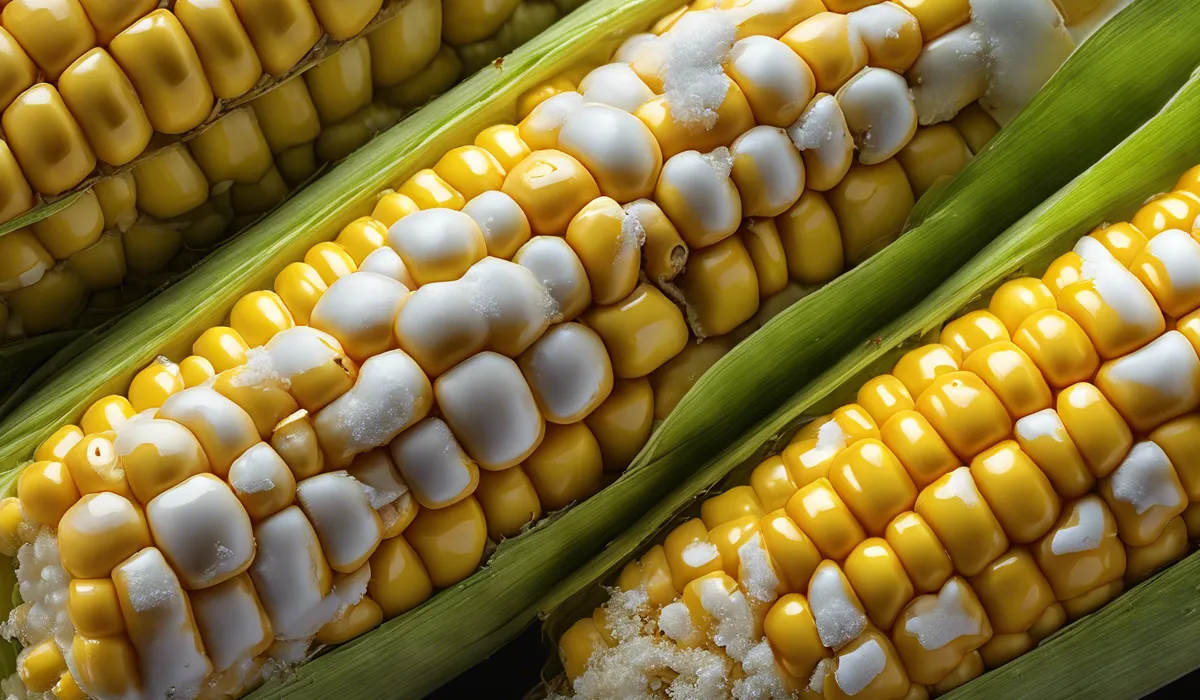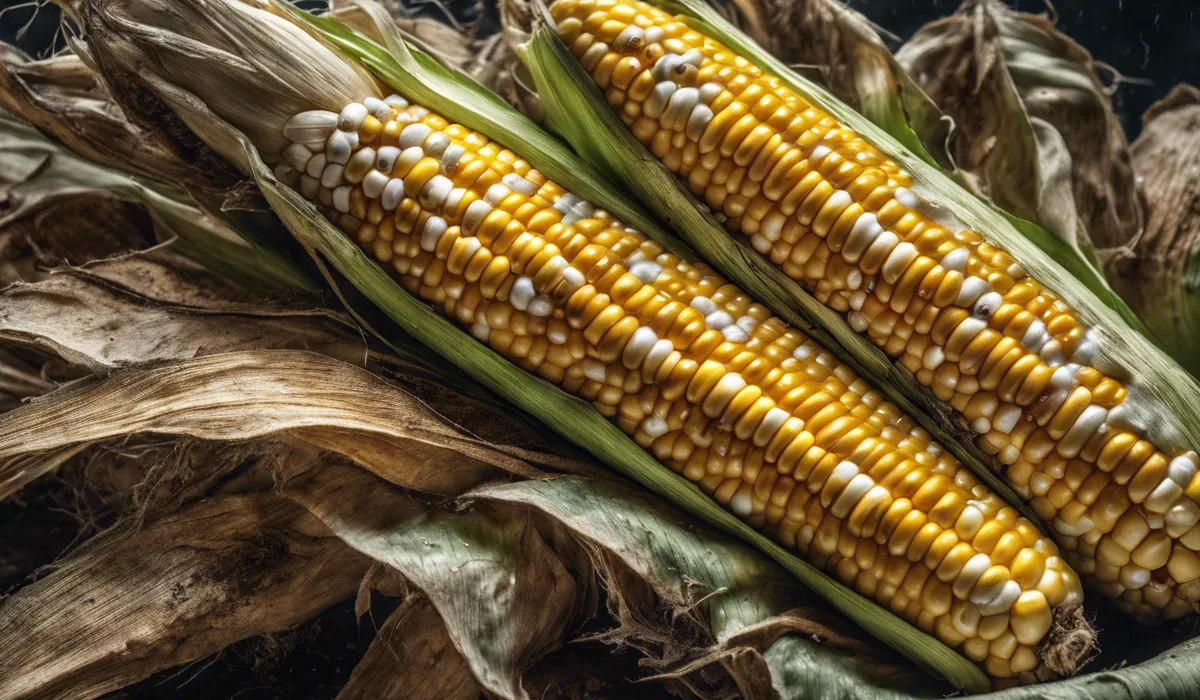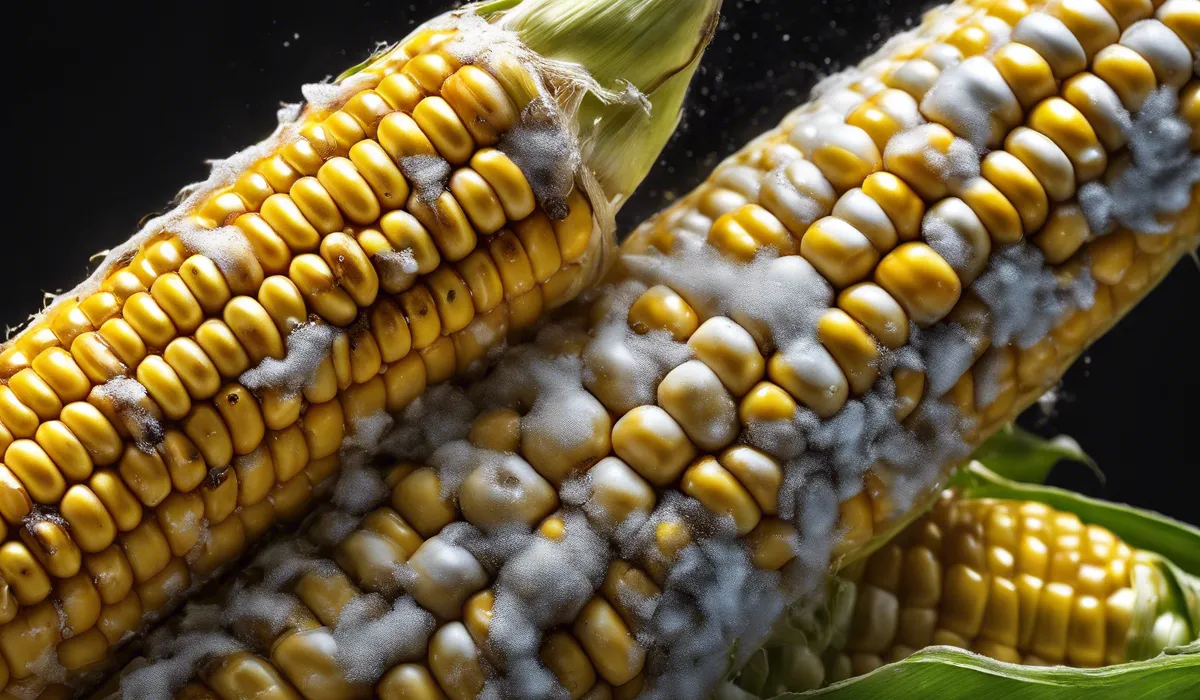Mold on corn can produce mycotoxins, which are harmful if ingested. Consuming moldy corn might lead to food poisoning symptoms or more severe health issues. It’s crucial to discard mold-infested corn to avoid potential risks.
Understanding Mold on Corn

Definition of Mold
Mold is a type of fungus that grows in the form of multicellular filaments called hyphae. It thrives in moist environments and can spread quickly, appearing as fuzzy or slimy patches.
On corn, mold can affect any part, from the husk to the kernels, and it often causes discoloration or a musty odor.
Different Types of Mold That Can Affect Corn
There are several molds that can grow on corn, including Aspergillus, Fusarium, and Penicillium.
Aspergillus is known for its green or yellow color, while Fusarium can appear pink or red. Penicillium often has a blue-green hue. Each type has its characteristics and potential risks.
Conditions That Promote Mold Growth on Corn
Mold on corn is more likely to occur under certain conditions. High humidity, warm temperatures, and poor ventilation are prime factors for mold development.
Fields that have experienced rain or flooding are especially at risk. Storing corn in a damp environment can also promote mold growth.
Aflatoxins and Mycotoxins Produced by Certain Molds
Some molds produce toxic substances called mycotoxins. Aflatoxins are a type of mycotoxin that can be particularly harmful.
They are produced by certain species of Aspergillus mold and can contaminate corn if the conditions are right. These toxins can cause serious health issues if ingested.
Health Risks Associated with Moldy Corn

Short-term Health Effects of Consuming Moldy Corn
Eating moldy corn might lead to food poisoning with symptoms like nausea, vomiting, diarrhea, and abdominal pain.
These reactions typically happen soon after consumption and can affect anyone who eats the contaminated corn.
Long-term Health Risks and the Impact of Mycotoxins
Long-term exposure to mycotoxins, particularly aflatoxins, can lead to more severe health issues.
These include liver damage, immune system suppression, and an increased risk of cancer. Chronic exposure to these toxins is a serious concern for overall health and wellbeing.
Specific Dangers of Aflatoxins in Moldy Corn
Aflatoxins are among the most carcinogenic substances known. They can cause liver cancer and are particularly dangerous for individuals with pre-existing liver conditions.
Even in small quantities, aflatoxins can be extremely harmful over time.
At-risk Populations for Health Complications from Moldy Corn
People with weakened immune systems, the elderly, young children, and those with liver disease are at higher risks of health complications from moldy corn.
These groups should be especially careful to avoid consuming any corn that might be contaminated with mold.
Guidelines for Identifying Hazardous Mold on Corn
To identify hazardous mold on corn, look for discoloration, a musty smell, or a powdery or fuzzy texture.
Corn with any of these signs should be considered dangerous and not fit for consumption. When in doubt, it is best to err on the side of caution and discard the corn.
Prevention and Handling of Moldy Corn

Agricultural Practices to Prevent Mold Growth
Preventing mold begins in the field. Farmers can use crop rotation, plant resistant corn varieties, and ensure proper field drainage to reduce the risk of mold.
Timely harvesting and avoiding injury to the corn during harvesting can also prevent mold infestation.
Proper Storage Conditions for Corn to Avoid Mold
After harvest, corn should be dried to an appropriate moisture level and stored in a cool, dry place.
Good ventilation is essential to prevent moisture buildup. Regular inspections can help detect any mold development early on.
Safe Handling Procedures for Moldy Corn
If mold is detected on corn, it’s important to handle it safely. Wear protective gloves and a mask to avoid inhaling spores or coming into direct contact with the mold.
Isolate the affected corn to prevent the spread of mold to uncontaminated areas.
When to Discard Moldy Corn and When It’s Salvageable?
Generally, moldy corn should be discarded to avoid health risks. However, if only a small portion of the corn is affected and the rest appears healthy, it may be salvageable. Remove and dispose of the moldy parts, and carefully inspect the remaining corn before considering it safe to use.
Tips for Cleaning and Salvaging Partially Affected Corn
To salvage partially affected corn, remove the moldy kernels and thoroughly clean the remaining ones.
It may be advisable to cook the corn at high temperatures to kill any potential spores. However, if there is any doubt about the safety of the corn, it is best to discard it altogether.
FAQs About Mold on Corn
Is it safe to eat corn with mold on it?
No, eating moldy corn is unsafe because the mold can produce mycotoxins that are harmful if ingested.
Can mold on corn cause food poisoning?
Yes, consuming moldy corn can lead to food poisoning symptoms due to the presence of mycotoxins.
What should I do if I find mold on my corn?
If you find mold on corn, it is crucial to discard it to avoid the potential risks of mycotoxin exposure.
Are the health issues from eating moldy corn serious?
Consuming moldy corn can lead to serious health issues, especially if the mold has produced mycotoxins.
How can I prevent mold from growing on corn?
Prevent mold on corn by storing it in a cool, dry place and consuming it before it spoils or shows any signs of mold.
Final Thoughts
Moldy corn poses health risks due to the potential production of mycotoxins, which are harmful when ingested.
Consumption can result in food poisoning or more severe consequences. To safeguard health, it’s imperative to dispose of any corn showing signs of mold contamination.
